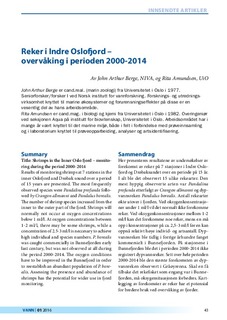| dc.contributor.author | Berge, John Arthur | |
| dc.contributor.author | Amundsen, Rita | |
| dc.date.accessioned | 2018-10-17T07:46:18Z | |
| dc.date.available | 2018-10-17T07:46:18Z | |
| dc.date.created | 2017-03-02T13:04:53Z | |
| dc.date.issued | 2016 | |
| dc.identifier.citation | Vann. 2016, 51 (1), 43-57. | nb_NO |
| dc.identifier.issn | 0042-2592 | |
| dc.identifier.uri | http://hdl.handle.net/11250/2568376 | |
| dc.description.abstract | Her presenteres resultatene av undersøkelser av forekomst av reker på 7 stasjoner i Indre Oslofjord og Drøbaksundet over en periode på 15 år. I alt ble det observert 15 ulike rekearter. Den mest hyppig observerte arten var Pandalina profunda etterfulgt av Crangon allmanni og dypvannsreken Pandalus borealis. Antall rekearter økte utover i fjorden. Ved oksygenkonsentrasjoner under 1 ml/l vil det normalt ikke forekomme reker. Ved oksygenkonsentrasjoner mellom 1-2 ml/l kan det forekomme noe reker, mens en må opp i konsentrasjoner på ca. 2,5-3 ml/l før en kan oppnå relativt høye individ- og artsantall. Dypvannsreken ble tidlig i forrige århundre fanget kommersielt i Bunnefjorden. På stasjonene i Bunnefjorden ble det i perioden 2000-2014 ikke registrert dypvannsreker. Sett over hele perioden 2000- 2014 ble den største forekomsten av dypvannreken observert i Gråøyrenna. Skal en få tilbake det rekefisket som engang var i Bunnefjorden, må oksygensituasjonen forbedres. Kartlegging av forekomster av reker har et potensial for bredere bruk ved overvåking av fjorder. | nb_NO |
| dc.description.abstract | Title: Shrimps in the Inner Oslo fjord – monitoring during the period 2000-2014. Results of monitoring shrimps at 7 stations in the inner Oslofjord and Drøbak sound over a period of 15 years are presented. The most frequently observed species were Pandalina profunda followed by Crangon allmanni and Pandalus borealis. The number of shrimp species increased from the inner to the outer part of the fjord. Shrimps will normally not occur at oxygen concentrations below 1 ml/l. At oxygen concentrations between 1-2 ml/l, there may be some shrimps, while a concentration of 2.5-3 ml/l is neccesary to achieve high individual and species numbers. P. borealis was caught commercially in Bunnefjorden early last century, but was not observed at all during the period 2000-2014. The oxygen conditions have to be improved in the Bunnefjord in order to reestablish an abundant population of P. borealis. Assessing the presence and abundance of shrimps has the potential for wider use in fjord monitoring. | nb_NO |
| dc.language.iso | nob | nb_NO |
| dc.publisher | Norsk vannforening | nb_NO |
| dc.title | Reker i Indre Oslofjord - overvåking i perioden 2000-2014 | nb_NO |
| dc.type | Journal article | nb_NO |
| dc.type | Peer reviewed | nb_NO |
| dc.description.version | publishedVersion | nb_NO |
| dc.source.pagenumber | 43-57 | nb_NO |
| dc.source.volume | 51 | nb_NO |
| dc.source.journal | Vann | nb_NO |
| dc.source.issue | 1 | nb_NO |
| dc.identifier.cristin | 1455346 | |
| dc.relation.project | Andre: Fagrådet, vann- og avløpsteknisk samarbeid i Indre Oslofjord | nb_NO |
| cristin.unitcode | 7464,20,12,0 | |
| cristin.unitname | Marin forurensning | |
| cristin.ispublished | true | |
| cristin.fulltext | original | |
| cristin.qualitycode | 1 | |
